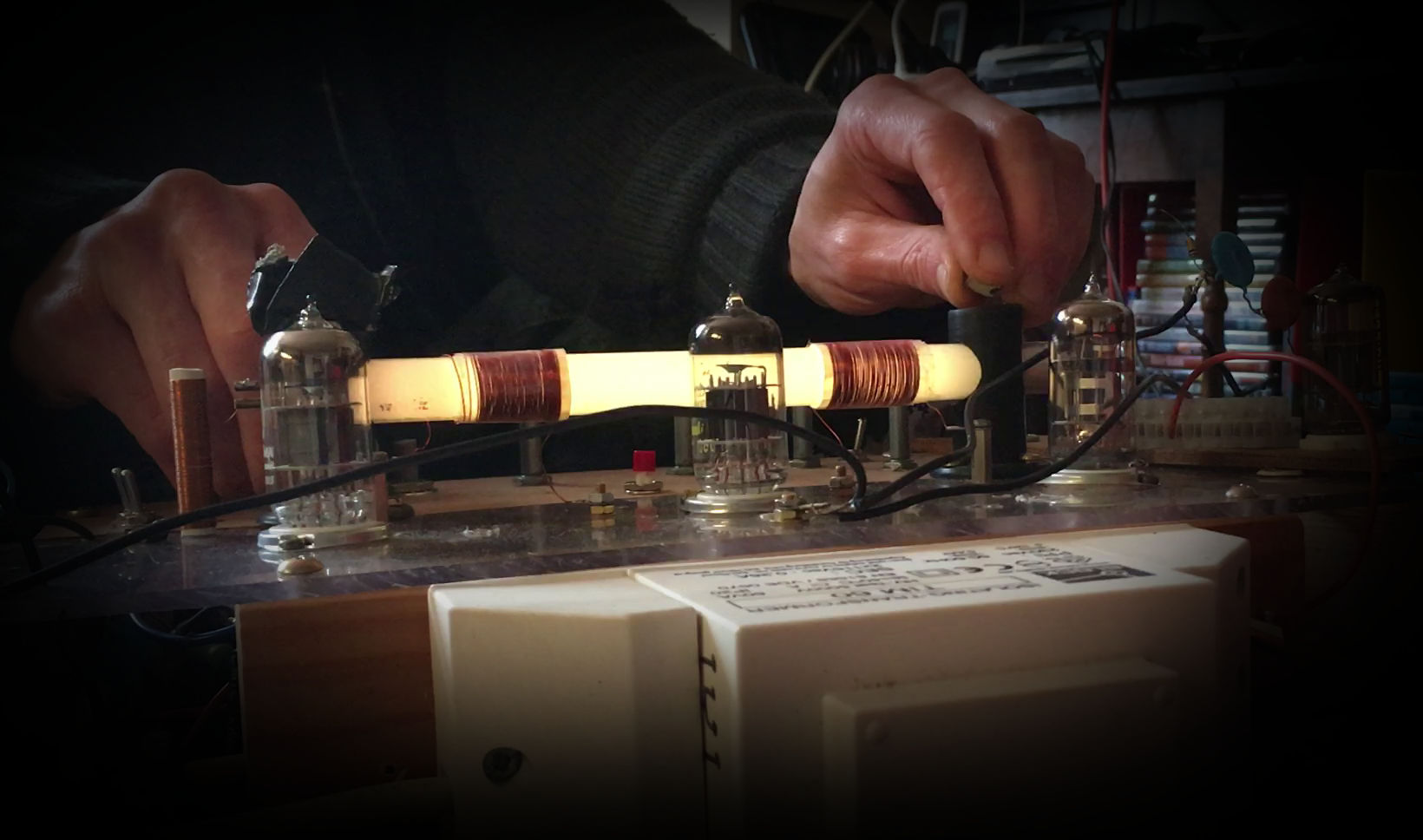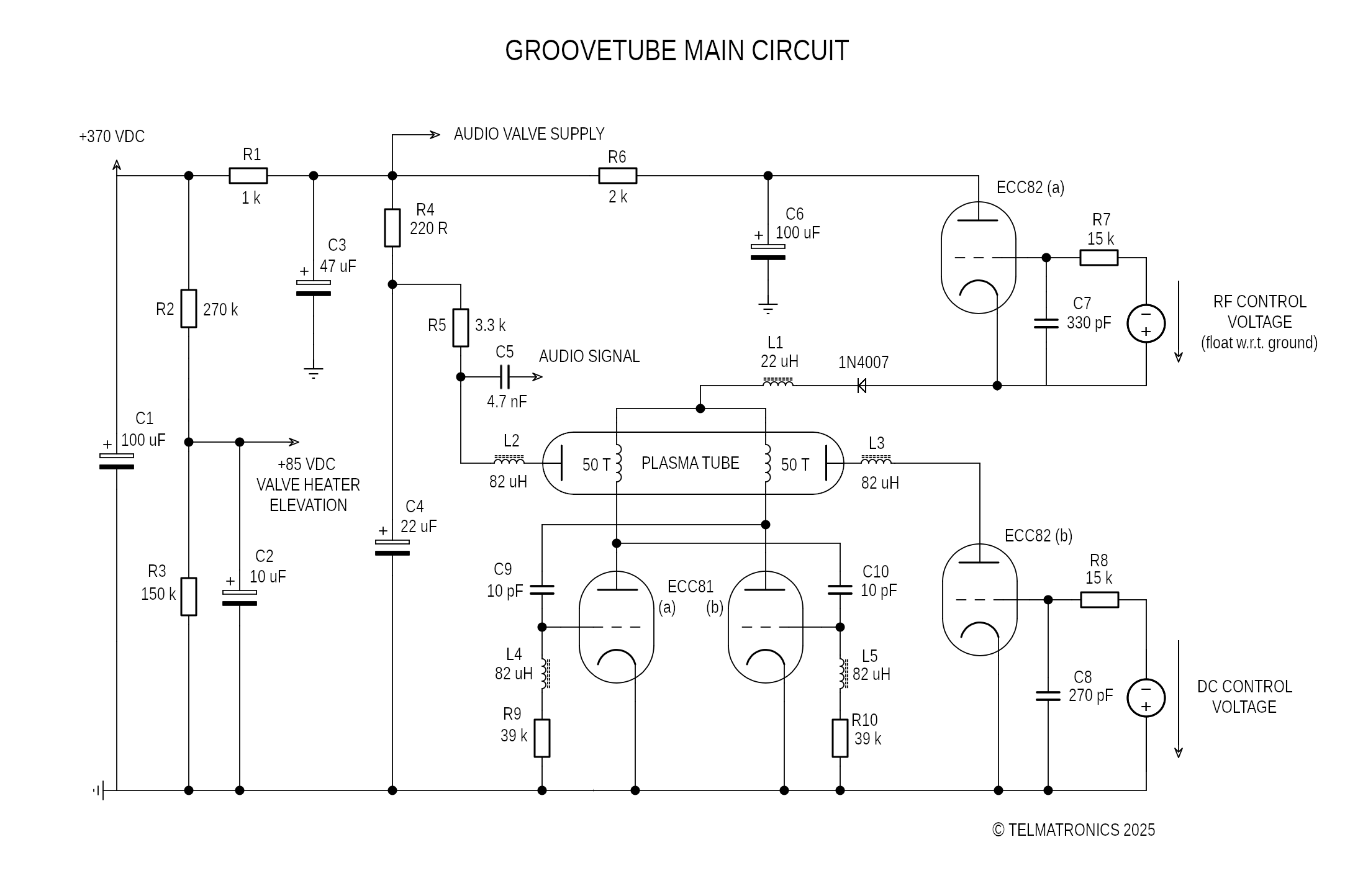Background to Plasma Sound

We wanted to make some kind of audio component with a plasma, so you could control sound with a magnet. This turned out to work pretty well for noise produced in fluorescent tubes, which could be filtered/suppressed or in some cases created with a magnet. The plasma noise can also interact with input signals, to make some pretty crazy sounds.
This page has got technical details, prototype demos and other background stuff.
Plasma
A plasma is an electric flame - glowing gas energetic enough to be ionised, which makes it fluid and electrically conductive. It exists in many forms, from inside a neon indicator bulb to the heart of a star or lightning bolt.
Passage of electric current through a plasma is often unstable - the current consists of fast charged particles, which can cause more ionisation, making the plasma more conductive and so allowing more current to flow, etc...
This negative differential resistance makes the voltage required to sustain the plasma lower than the striking voltage, which lets relaxation oscillations occur.
Making noise with plasma
We found passing a low DC current through a small fluorescent tube would make noise with a frequency content that broadly varied with tube voltage. Interestingly, applying an increasing amount of radio-frequency (RF) energy to the plasma could then change the noise, often as a filtering of harsh sounds to purer tones, until the current ultimately became stabilised - able to change the plasma's behaviour in a circuit between smoothly conductive and noisily unstable. Separately modulating the DC and RF supplies causes a tube to make a wide range of vocal noises, that often sound really funny - shrieks, whistles, buzzes, squeaks, farts, groans...
The short film below shows our first dual-modulated prototype:
Different fluorescent tubes can produce quite different sounds. This video has clips of six types of tube making a range of noises:
The plasma noise is sensitive to magnetic fields and a strong magnet can affect the sound in different ways at the two electrodes. Magnetic fields cause electron paths to curve, and these effects likely occur as this enhances electron activity.
A fluorescent tube is sealed and contains only a tiny amount of gas, so to hear really acoustic and animalistic noises was surprising. These kinds of noise are often made as gas flows through some kind of constriction - stretching the neck of a balloon, or squeezing air past vocal cords - and the dynamics of current flow in a plasma like this seem to be analogous enough for them to sound similar. The potential of a plasma is determined by populations of positive ions and negative electrons, delicately balanced so that equal currents of each can flow for it to exist at all. These currents are regulated through sheath regions at the electrodes, which seem to be where much of the sound can be affected by the magnet.
Plasma in a synth
Glowing gas that can make weird noises is pretty special stuff, but on its own doesn't really make a musical instrument. Plasma's ability to fluctuate and generate noise has been successfully used before to make tone oscillators, in early electronic instruments like the Trautonium.
These however needed various types of external circuit to keep them in tune, and we've instead experimented with applying tuned signals to the tube control circuit, which then interact with the plasma's own dynamic behaviour in different ways depending on how the tube is driven.
This arrangement is essentially a valve pre-amp that sources its current through the plasma tube, with an internal oscillator to generate the 'input' tuned signal. Strong input signals with lots of plasma noise generally make an overdriven sound, and at different conditions the output can vary to sound a bit like brass, reed or string instruments.
Tubes and electrodes
Almost all experiments so far have been done with fluorescent lamps, though we are now starting to prototype custom tubes with Julia at www.neonunity.co.uk, who will be making tubes for the synths. We still have lots to find out about what noises can be made with different types of plasma tube.
Sounds produced by fluorescents can vary a lot, even between tubes of same brand/spec. Many do not have a stable region within the operating range at first, and some go through a periodic cycle of noise/brightness. These instabilities likely occur due to small variations in the coating applied to the electrodes to lower the work function (potential barrier electrons have to overcome to leave the surface), which erodes from particle bombardment, and the distribution of the small amount of mercury in the tube. Much of the variation is reduced after a few hours' use, and a small magnet near to the anode helps to stabilise excessive noise.
Schematic


NB - updated with correct R3 value Nov'25

And why telmatronics?
Telmatron means something like 'swamp tube' - chosen for the effect of the RF plasma excitation, which does progressively swamp the audio signal. It also seems appropriate for the wet noises some tubes make!
Links
These sites have been interesting and/or helpful for this project. Much information about plasmas and synthesisers is online, wikipedia is brilliant.
Fascinating history of electronic instruments
https://120years.net/wordpress/
Julia Bickerstaff's awesome neon creations
www.neonunity.co.uk
Great collection of unusual instruments and resources
http://www.oddmusic.com/
Crazy synthesisers!
http://www.deviantsynth.com/
Fantastic resource for valve circuit design
http://www.valvewizard.co.uk/
Another great site for valve electronics
https://www.angelfire.com/electronic/funwithtubes/
GBVP - a project to restart valve manufacture in the UK
https://brimaruk.com/menugbvp/great-british-valve-project-2/
Synth news sites
https://www.matrixsynth.com/
https://www.synthtopia.com/
https://synthanatomy.com
